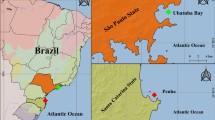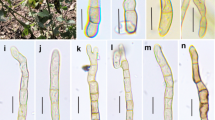Conclusion
The observations recorded in the foregoing pages thus warrant the following general conclusion with regard to the origin of the amphiphloic siphonostele inSelaginella:
The origin of the siphonostele inSelaginella is correlated with the polystelic condition and the amphiphloic siphonostele originated as a result of a fusion of a number of separate steles. The polystelic condition probably originated in response to the necessity of increasing the amount of conducting and mechanical tissues in the absence of provision for secondary growth. The pith is extrastelar in origin and the presence of internal phloem and internal endodermis is directly due to the origin of the siphonostele from the polystelic condition.
Similar content being viewed by others
References
Boodle, L. A. “Comparative anatomy of the Hymenophyllaceæ, Schizæaceæ and Gleicheniaceæ. IV. Further observations on Schizæa,”Ann. Bot., 1903,17, 511.
Bower, F. O. “On the primary xylem and the origin of medullation in the Ophioglossaceæ,” —, 1911,25, 537.
— “On the medullation in the Pteridophyta,” —, 1911,25, 555.
-Size and Form in Plants, 1930.
Eames, A. J., and MacDaniels, L. H.An Introduction to Plant Anatomy, 1925.
Gibson, R. J. H. “Contributions towards a knowledge of the anatomy of the genus Selaginella. I. The stem,”Ann. Bot., 1894,8, 133.
Gwynne-Vaughan, D. T. “Some remarks on the anatomy of the Osmundaceæ,” —, 1911,25, 525.
Jeffrey, E. C. “The morphology of the central cylinder in vascular plants,”Rep. Brit. Assocn., Toronto, 1897, 869; London, 1898.
-The Anatomy of Woody Plants, 1917, 283–91.
- “The Pteropsida,”Bot. Gaz., 1910, 401.
Mitchell, G. “Contribution towards a knowledge of the anatomy of the genusSelaginella Spr. V. The Strobilus,”Ann. Bot., 1910,24, 19.
Scott, D.H. “Origin of polystele in dicotyledons,” —, 1891,5, 514.
Tansley, A. G. “Lectures on the evolution of the Filicinean vascular system. Lecture V. The evolution of the solenostele,”New Phyt., 1907,6, 148.
— “Lectures on the evolution of the Filicinean vascular system. Lecture IX. The leaf-trace. Ontogeny,” —, 1908,7, 1.
Author information
Authors and Affiliations
Additional information
Communicated by Dr. H. Chaudhuri
Read before the monthly meeting of the Botanical Society of Bengal, 1941.
My thanks are due to Dr. A. C. Joshi for his kindly going through the MSS. and many helpful suggestions which have considerably enhanced the value of the paper.
Rights and permissions
About this article
Cite this article
Majumdar, G.P. The origin of siphonostele in three species ofSelaginella spr.. Proc. Indian Acad. Sci. 15, 172–177 (1942). https://doi.org/10.1007/BF03048756
Received:
Issue Date:
DOI: https://doi.org/10.1007/BF03048756




